Steakhouse etiquette is both formal and casual at the same time thanks to elegant settings combined with foods you can eat with your hands. No wonder the average diner is confused!

12 Steakhouse Etiquette Mistakes Everyone Makes


Ignoring the dress code
Steak restaurants have a dress code for a reason, and it’s not just because your mom wants you to take off that hoodie. “Dress codes enhance the dining experience for everyone,” says etiquette coach Jules Hirst, founder of Etiquette Consulting and co-author of The Power of Civility. “Ignoring it can make you feel out of place and detract from the ambiance.” Additionally, at some establishments where the dress code is strictly enforced, you may be politely asked to don a loaner sports coat (select steakhouses may offer clothing loans) or, worse, you may be asked to leave.
After all, restaurants spend millions of dollars to create an atmosphere that will help make your special occasion feel more so, says Paul Mihailides, founder of The Preserve Sporting Club & Resort and its on-site steakhouse, Double Barrel Steak in Richmond, Rhode Island. However, he adds, “A common misperception is that you need to dine in formal business attire, like Don Draper in the 1950s.” This is not necessarily true, as Jovan Fitzgerald Duncan, general manager at celebrity chef Scott Conant’s The Americano, notes that his restaurant’s dress code is upscale casual. But “Why not embrace the opportunity to glam up and elevate your dining experience?” he asks.
What to do instead: “If you are unsure of what to wear, look at the steakhouse’s website and social media to see what other patrons wear,” Hirst says. And even if there is no stated dress code, “it’s a sign of respect to your dining companions and the restaurant itself to dress in a way that puts your best foot forward,” adds Thomas P. Farley, aka “Mister Manners,” contemporary etiquette expert and creator/presenter of corporate dining etiquette program “Doing Client Deals Over Meals.”
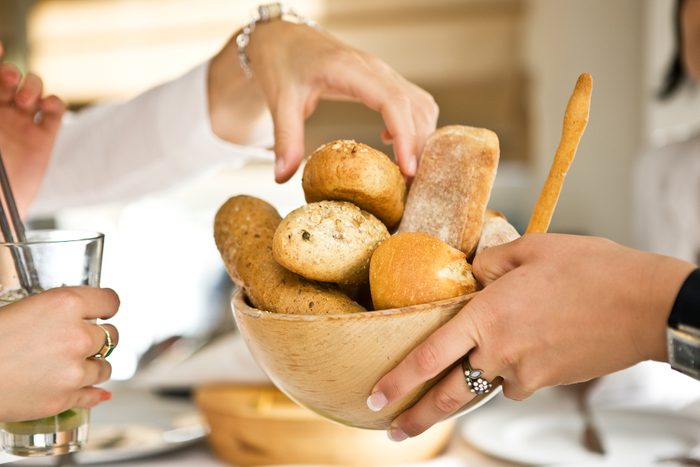
Holding the bread basket hostage
It’s not uncommon to prepare oneself for a big steak dinner by skipping lunch to build up a ravenous hunger worthy of such a carnivorous course. But sitting down starving can lead to instinct over etiquette, especially when the more-than-welcome bread basket drops.
What you don’t want to do is snatch at the bread and dive right in the second the server places it on the table. You also don’t want to bogart the basket as you pick through it with your hands. And resist grabbing the basket, a piece of bread, then buttering it over the basket instead of passing the basket around. Other common errors include buttering directly from the butter dish, using your personal butter knife when there is a spreader and double-dipping your bread into a communal oil infusion—also an Italian restaurant etiquette mistake!
What to do instead: If the bread basket lands before you, it’s your responsibility to pass it around, preferably to your right, after you take your one piece. As for where to place it, Hirst uses a helpful BMW pneumonic device to help identify which bread or side plate is yours. “Your bread plate (B) is on the left, meal plate (M) in the middle and water glass (W) is on the right,” she says.
Instead of holding the butter hostage or forcing the table to wait while you butter your whole bread, “When you get the butter, take a small amount and place it on your bread plate,” she says. Duncan adds, “Use the bread knife/spreader, not your dinner knife.” Break off a piece of bread that is small enough to chew without it changing the shape of your mouth. Then apply the butter to that bite-sized bread (not the whole piece) bread knife, and eat it.
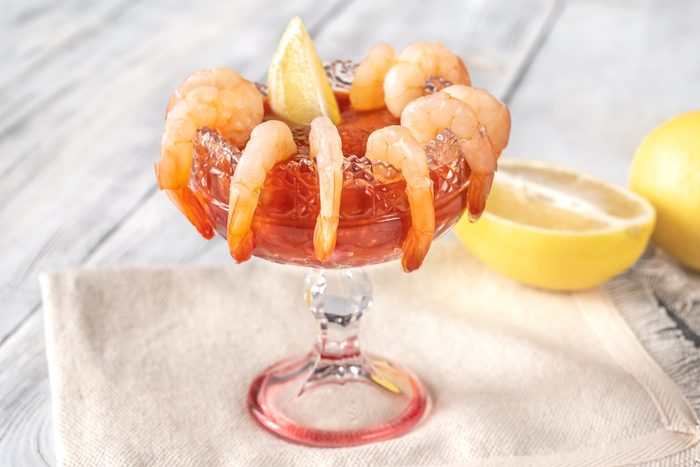
Being too formal with your shrimp cocktail
Although this sounds like an oxymoron, luxurious shrimp cocktail is actually one of the least formal classic appetizers to order and eat at a steakhouse. But because of the setting, it’s easy to confuse whether you ought to use a fork and knife when eating it. And then you have to think about the lemon wedge—which is not for garnish only—and cocktail sauce, which can be an unfortunate hotbed for double-dipping. Fortunately, this is one dish that doesn’t need overthinking.
What to do instead: First, ask your fellow diners if they like a refreshing squirt of lemon juice on their shrimp cocktail. If the answer is yes, squeeze the lemon wedge evenly over all of the shrimp and place it to the side. If not, you may squeeze it over your shrimp immediately before eating your own.
The good news is, you can go ahead and eat with your hands, Hirst says! “Shrimp are often served with the tail still on, which makes it perfectly acceptable to pick them up with your fingers. Grasp the tail, dip the shrimp into the cocktail sauce”—generously to coat the entire thing since biting and re-dipping is a definite nope —”and take a bite. You should eat the entire shrimp up to the tail in one bite, then place the shrimpless tail on the edge of your plate.”
However, if the shrimp is jumbo and you’re in a very formal setting, use the silverware provided instead of your fingers to make it more manageable. It would seem inelegant to eat jumbo shrimp with your fingers at a formal restaurant.
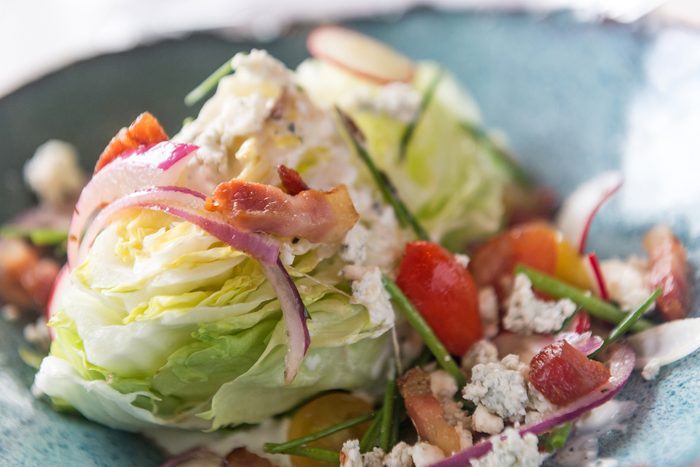
Butchering your wedge or Caesar salad
Iceberg wedge salads, dressed with blue cheese, bacon and tomatoes, are a steakhouse staple, as are Caesar salads. The latter can seem like a less foolhardy choice since it’s traditionally served chopped and dressed … but deconstructed versions have become ever more popular, putting them in the same category as the dramatic but sometimes problematic Wedge. It’s easy to awkwardly massacre your greens and make a mess across the table (guilty!), but our professionals tell us there are better ways.
What to do instead: “Although delicious, a wedge salad is a lot to tackle,” Hirst admits. But “no matter the size, you still only cut and eat one piece at a time,” she advises. This holds true for whole-leaf Caesar salads, too. Hirst adds, “The goal is to minimize the mess and keep your plate looking neat and appetizing.” It is also acceptable to request that the kitchen chop a wedge salad for you when you’re ordering.
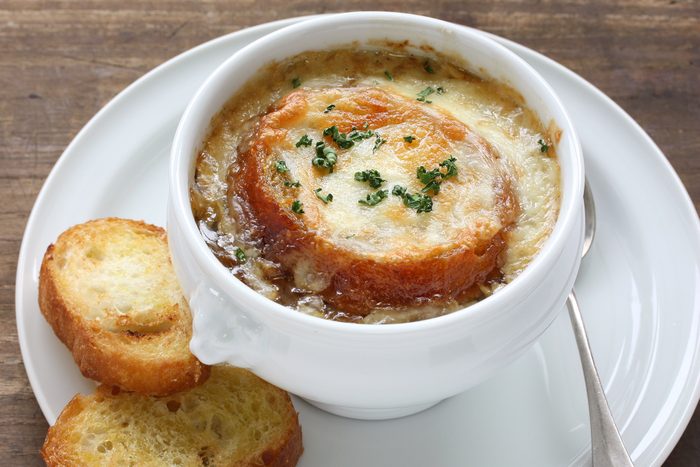
Giving in to the cheese pull on your French onion soup
Cheese pulls are very popular on social media; what could look more enticing than a long, gooey stretch of melty cheese? However, in a refined environment like a steakhouse, it’s uncouth to show off your dairy for clout, which makes eating delicious French onion soup a significant challenge, especially when you consider all the various textures. Beyond avoiding an obvious cheese pull, you also have to contend with the toasted crouton under it, the textures of the caramelized onion, and the liquid broth of the soup itself.
What to do instead: “As bizarre as it sounds, French onion soup is a soup that requires a knife to eat!” Hirst shares. Knife in hand, “Cut through the cheesy top and let the trapped steam escape. Once the soup has cooled sufficiently, take your spoon and scoop the soup from the edge to avoid a cheesy mess. If the cheese fails to break apart, you can use your knife to cut the cheese into manageable bites,” she says. When that hard part is over and only the broth remains, you have the green light to switch back to traditional soup etiquette and scoop the soup away from you. However, she reminds that even then, “no matter the soup, it’s not proper etiquette to blow on it to cool it.”

Cutting up your steak all at once
This is so egregious that Hirst names this as his biggest pet peeve when it comes to steakhouse etiquette. But again, there’s a practical reason it’s considered rude. “It can affect the temperature by cooling it down too much,” per Duncan. Milhailides also argues, “You are allowing all of the moisture, the ‘juices’ to flow out of the meat, rendering it tougher to eat” … and considerably less enjoyable!
However, he notes, “Many trained and talented servers will request that you cut into the center of your steak while they are still present at the table” to ensure it is cooked to the proper temperature to ensure you don’t need to send it back.
On the other hand, Duncan says, it’s a bit different when the steak is sliced before you by a server. “Tableside activations are meant to engage you as a performance of skill. It is respectful to observe the experience and show appreciation,” he elaborates. But eating these slices whole instead of further breaking each one down into bite-size pieces is a no-no.
What to do instead: As with any entree, a steak should be cut one bite at a time, preferably against the grain. Steaks that are carved tableside are often in larger pieces, so it will be necessary to cut those into smaller bites. You should remain seated and attentive as it is cut, Duncan says.
Regardless of whether the steak is served whole or sliced, hold the fork in your nondominant hand and the knife in your dominant hand, Farley says. (Since most people are right-handed, the fork will go in your left hand and the knife will go in your right, but it’s perfectly acceptable for lefties to discreetly switch the utensils as needed.) Utensils should remain that way as you continue to enjoy your meal if you’re dining in the Continental/European style.
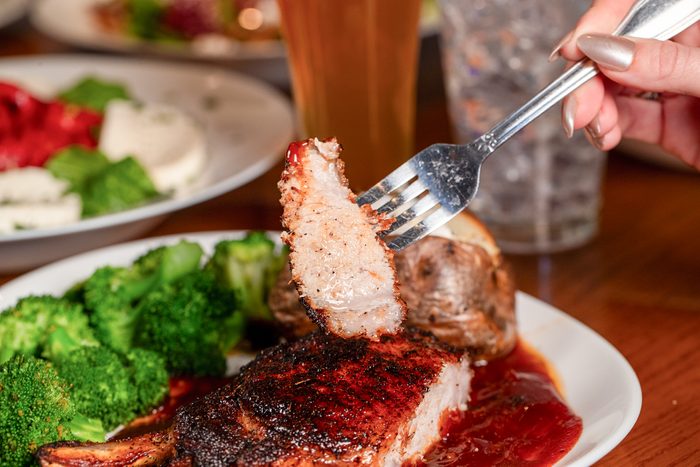
Dousing your steak in sauce
There is no faster way to cause offense to a steakhouse than to doctor the steak before your first bite. “High-quality steakhouses pride themselves on serving perfectly cooked and seasoned cuts of meat. Adding too much of anything—even any of our five incredible sauces—can ruin a good steak,” Duncan explains. Additionally, he feels asking for ketchup or A1 “is often seen as a bit too casual and can imply that the steak lacks flavor.” Hirst calls it a “culinary crime” in the eyes of finer steakhouses since, as Farley expands, “Quality steaks are typically prepared with great care and attention, often with generous amounts of butter. Dousing your cut of beef with a supermarket condiment deprives your taste buds of an elevated experience,” and echoing Duncan, he suggests guests “bear in mind that many steakhouses will have their own special sauces.”
“High-quality steakhouses pride themselves on serving perfectly cooked and seasoned cuts of meat. Adding too much of anything—even any of our five incredible sauces—can ruin a good steak,” Duncan explains. Additionally, asking for ketchup or A.1. Original Sauce may be viewed as a culinary crime. “Quality steaks are typically prepared with great care and attention, often with generous amounts of butter,” Farley says. “Dousing your cut of beef with a supermarket condiment deprives your taste buds of an elevated experience.”
As for an automatic reflex to reach for the saltshaker, “to salt before tasting presumes the chef has underseasoned your meal,” Farley says, an interpretation that carries through to every restaurant category.
What to do instead: If you’ve ordered a house sauce to enhance your meal, “put the sauce on the side of your plate to dip each piece into, which is more than enough to complement the steak without overshadowing its taste,” Hirst says. Another alternative: Use your knife to transfer the sauce to your meat instead of dipping, since it can be considered impolite to dip food into anything, according to some etiquette experts. Need salt? The golden rule here is not to add it until you’ve taken your first bite!

Making faux pas with the food pass
At many upscale steakhouses, side dishes—think creamed spinach, mashed potatoes or crispy onion rings—are often ordered a la carte for sharing. However, there is room for missteps if you’re used to individually divided portions. Again, you’ll have to fight the urge to hog your favorite and taste it immediately, Duncan mentions, and you’ll also have to wait until everyone has a little something before you start in.
With sides, no-nos start with eating directly from a side dish’s serving ware instead of doling it onto your individual plate, or licking the serving spoon and replacing it in the dish or using it as your own. These faux pas ought to be avoided just as much for sanitary reasons as they are for etiquette. And whatever you do, don’t take all, or even most of, what’s meant to be shared.
What to do instead: The same rules for passing and starting with bread are echoed for sharing sides. Pass to the right rather than reaching across the table, and either wait or ask politely for a dish to be handed down. But also, “Make sure each shared dish has its own serving utensils; never use your personal utensils to serve a shared dish,” Hirst says. But good news if the sides are plentiful: “It is acceptable to ask the server for an extra plate to use if there’s no room on your plate,” she confirms. Most importantly, always start small to make sure that there’s enough to go around.

Eating vegetables with your hands
It’s not uncommon to see broccoli rabe, whole green beans, long carrot slices and, most notably, asparagus on steakhouse menus as sides. Because of their length, it’s often mistaken that you can treat them like shrimp cocktail and that it’s acceptable to just pick them up for consumption. However, it’s a gray area since it depends on temperature, how it’s prepared and what it’s served with.
What do do instead: When vegetables are served cut and raw as crudités for a dip or chilled, “pick each one up by the base and enjoy,” Hirst says. “If they are served warm and covered with a sauce, then you should use a knife and fork.” The same goes for potato or fried sides—if a sauce is involved, you’ll want to put your flatware to use.
That said, most of the time, onion rings and steak fries are fair game for fingers. In a more formal steakhouse, though, you might want to use your fork and knife for those onion rings, especially if they’re particularly big or greasy.

Spitting gristle or fat into a napkin
Because it’s not easily identified in a raw piece of meat, you may bite into a piece of gristle or cartilage when dining at even the finest of steakhouses. Of course, it is more likely to occur when eating a less expensive cut of beef, but if you do come upon gristle, refrain from spitting it into a cloth napkin (“Pity the poor server who clears that napkin!” says Farley) or directly onto your plate.
Not to be confused with gristle, however, is fat. “Trimming all the fat off your steak might seem like a good idea, but the fat actually contains a lot of the flavor,” Hirst says. In fact, it’s the entire reason cuts like a well-marbled ribeye and Kobe beef are prized so highly.
What to do instead: “The polite way to remove visible gristle is to discreetly use a sharp steak knife and your fork to separate it from the edible parts of your steak,” Duncan says. “Once separated, you can place it on the edge of your plate.” This visibility is an important nonverbal cue. “If the amount of gristle is excessive, it red-flags the server or manager to check in with the guest and correct the situation,” Milhailides says.
If it’s already in your mouth, you can do one of two things. “Etiquette dictates the way the food goes in is the way it comes out,” Hirst says. “Transfer it from your mouth to your fork, then the fork to the side of your place as subtly as possible.” Subtly is the key word there. Other etiquette experts are not a fan of this practice and instead recommend using your fingers to extract the unwanted food while covering your mouth with the other hand so no one sees the unsightly piece of food. Then you should hide the half-chewed gristle under something else on your plate—a piece of lettuce, for example.
As for how to eat steak fat, Hirst recommends divvying up some of the fat to accompany each bite “to add to the richness of the flavor. But if fat is not your cup of tea, trim the fat off each bite, but not all at once.”
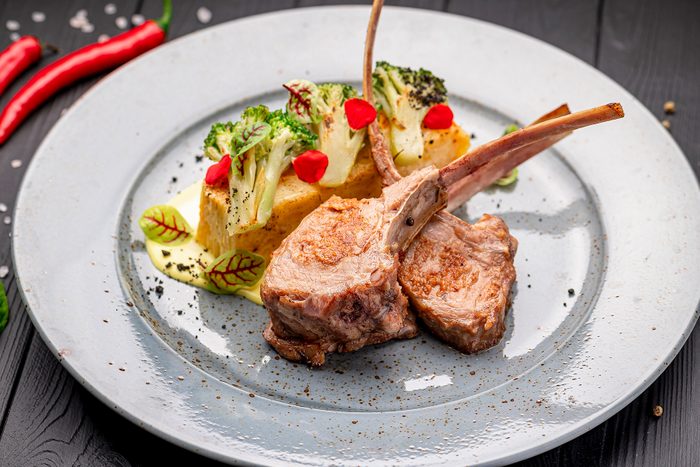
Gnawing on the bone in public
With a great bone-in steak like a tomahawk, which is often cut by the server and where there is sometimes plenty of juicy, flavorful meat left uncarved, or a lamb or pork chop, it may be hard to resist the temptation. But “this is what knives are for. You are not Henry VIII nor at a backyard barbecue. You are in a restaurant!” Farley reminds. “[Gnawing the bone] is messy, affects the presentation, and the ambiance of the restaurant,” Duncan says.
What to do instead: “If there is more meat on the bone for you to enjoy, do your decorous best with your utensils and ask to take the rest home,” Farley says. “How you finish the balance of the meat from the bone in the sanctity of your own home is between you and your plate.”

Picking the meat out of your teeth
It’s nearly inevitable that you’ll get steak stuck in your teeth while chewing. As uncomfortable as that is and as immediately as you want to resolve it, “Under no circumstances should your finger be used to try to wedge the food free while you are still at the table,” Farley says. “The same goes for using floss or a toothpick at the table.”
What to do instead: Despite his pescatarian status, Farley knows “it’s a good idea to bring dental floss when you dine at a steakhouse,” as even air and sea proteins are typically extra meaty there. But go to the restroom for your dental care or wait until you get home. And it should go without saying that wherever you floss, wash your hands before and after putting them in your mouth.
About the experts
|
Why trust us
Reader’s Digest has published hundreds of etiquette stories that help readers navigate communication in a changing world. We regularly cover topics such as the best messages to send for any occasion, polite habits that aren’t as polite as they seem, email and texting etiquette, business etiquette, tipping etiquette, travel etiquette and more. We’re committed to producing high-quality content by writers with expertise and experience in their field in consultation with relevant, qualified experts. We rely on reputable primary sources, including government and professional organizations and academic institutions as well as our writers’ personal experience where appropriate. For this piece on steakhouse etiquette, Su-Jit Lin tapped her experience as a longtime journalist who specializes in food for Reader’s Digest. Then Laura Windsor, a U.K.-based etiquette expert who was trained by a member of Queen Elizabeth II’s household and now advises international royals, celebrities and regular people, gave it a rigorous review to ensure that all information is accurate and offers the best possible advice to readers. Read more about our team, our contributors and our editorial policies.
Sources:
- Jules Martinez Hirst, etiquette expert, co-author of The Power of Civility and technical editor of Modern Etiquette for Dummies
- Thomas P. Farley, contemporary etiquette expert and creator/presenter of corporate dining etiquette program “Doing Client Deals Over Meals“
- Jovan Fitzgerald Duncan, general manager of The Americano by Scott Conant
- Paul Mihailides, founder of The Preserve Sporting Club & Resort and Double Barrel Steak




















